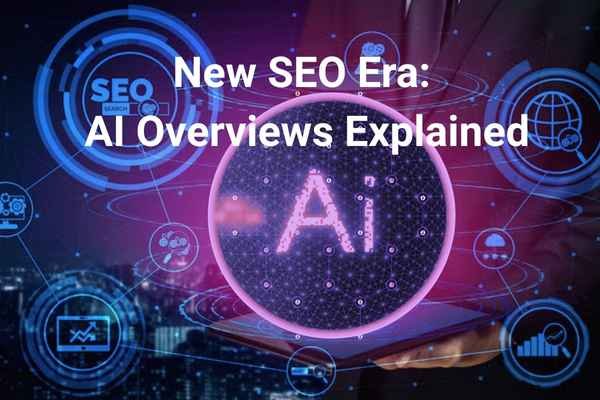
What Are Google AI Overviews and How Do They Work?
AI Overview is a new feature powered by Google’s Search Generative Experience (SGE) that appears as a summary box at the top of search results, blending traditional ranking signals with generative AI to deliver concise, context-rich answers.
So, what is the AI Overview’s meaning in simple terms?
Google’s AI Overviews are essentially machine-generated answers that appear directly within the AI snapshot in SERP (Search Engine Results Page). Instead of clicking through to individual websites, users can now get an instant summary—a trend known as zero-click answers. This feature is part of Google’s larger move toward machine learning in search, where the engine not only indexes content but also understands and synthesizes it on the fly.
How Do AI Overviews Work?
Behind the scenes, SGE uses large language models (LLMs) similar to ChatGPT to pull information from multiple trusted sources. These AI models then generate a readable summary that answers the user’s intent, often including follow-up prompts or suggested actions.
The process relies on
- Generative AI models trained on web-scale data
- Contextual understanding of user queries and related entities
- Confidence scores to determine whether or not to show an AI Overview
- Source attribution links to the original websites
Not every query triggers an AI Overview. Google is carefully testing this for certain query types—especially where users benefit from synthesized answers, such as product comparisons, how-to questions, or health-related topics.
What It Means for SEO Professionals
For SEOs, this is both a challenge and an opportunity. Sites that want to appear inside the AI snapshot in SERP must focus on structured, expert-level content, semantic clarity, and intent alignment. It’s no longer just about ranking—it’s about being chosen by the AI to represent the best answer.
If your content isn’t optimized for generative AI results, you risk being bypassed entirely in zero-click search journeys. But if you understand how machine learning in search interprets entities, language, and structure, you can win visibility even in this new era.
What Does the Future of SEO Look Like with Google AI Overviews?
As Google shifts toward AI-first search experiences, the traditional rules of SEO are evolving rapidly. The rollout of AI Overviews, part of Google’s Search Generative Experience (SGE), marks a paradigm shift—one where content quality, user intent, and machine understanding take precedence over outdated tactics like keyword density or exact-match domains.

So, what lies ahead for SEO professionals, bloggers, and digital marketers?
1. Intent-First Strategies Will Dominate
In the era of generative search, Google wants to surface the most helpful, context-aware, and complete answers, not just the most optimized ones. This means:
- Deep topic coverage will outperform shallow posts
- Searchers’ real questions and follow-ups will shape rankings
- Tools like AnswerThePublic and People Also Ask will become essential for mapping intent clusters
2. AI-Generated Summaries Will Reduce Clicks — But Not All Traffic
With AI snapshots offering quick, zero-click answers, some niches (especially definitions or simple how-tos) will see a decline in CTR. However:
- Long-form, experience-rich content will still draw traffic
- Pages that get cited in the AI Overview will earn visibility and trust
- Expect a split: fast info = AI, in-depth learning = your site
Learning how to optimize for AI snippet inclusion becomes key to staying visible.
3. Expertise and Trust Will Matter More Than Ever
Google’s AI doesn’t just summarize — it filters for trusted, authoritative sources. Future ranking systems will increasingly reward:
- Verified authorship and real-world credentials
- First-hand experience shared through case studies, results, and stories
- High EEAT signals across your site
In the AI content ecosystem, faceless, low-value pages will vanish from top positions.
4. SEO Tools Will Evolve Rapidly
Expect the rise of AI-focused SERP tools that track:
- Whether your content appears in AI Overviews
- How your competitors are cited in generative results
- Evolving ranking signals are not visible in classic SERPs
Platforms like Semrush, Frase, and Chrome Labs will likely develop AI-driven SERP evolution dashboards to help SEOs adapt.
5. Continuous Learning Will Be Essential
What works today may not work tomorrow. To succeed in the next SEO era:
- Stay updated on Google’s algorithm changes and AI experiments
- Follow thought leaders testing SGE and Search Overview strategies
- Treat SEO as a living system, not a checklist
The future of SEO isn’t about fighting AI—it’s about partnering with it. By creating rich, helpful, human-first content that AI respects and readers value, you’ll remain discoverable—even as Google’s search engine evolves into a true knowledge assistant.
Why Google’s AI Overviews Are Changing SEO Rules
As SEO professionals, we’ve seen Google evolve—from the days of 10 blue links to featured snippets, People Also Ask boxes, and now, AI Overviews. But this shift is deeper than just a UI update. It represents AI-driven search changes that are rewriting the rules of visibility, traffic flow, and ranking logic.
With Google’s Search Generative Experience (SGE), the traditional click-through journey is being shortened—or skipped altogether. Users are getting instant summaries inside the AI Overview, leading to what many SEOs now call the zero-click landscape. Your content may still “rank,” but if it’s not referenced or linked in that summary box, your visibility could drop—despite holding a top position.
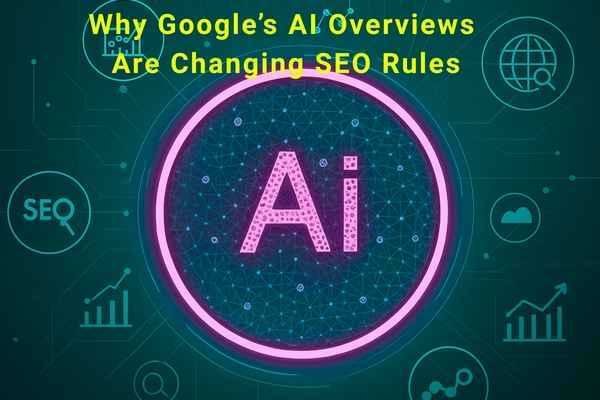
The Reality of Content Visibility Shifts
This change brings significant content visibility shifts. Previously, getting into the top 3 positions almost guaranteed you traffic. Today, traffic is split or intercepted by AI-generated answers. Google’s LLMs are essentially curating and summarizing the web for the user, reducing the number of clicks going to the original publishers.
For content creators and digital marketers, this means one thing: evolve, or become invisible.
Search Behavior Evolution Requires New Strategy
Search behavior itself is also changing. Users are now interacting with search more conversationally, thanks to generative AI. They’re asking follow-up questions, refining intent, and relying on Google’s AI to do more of the reading and comparing for them.
This means traditional keyword stuffing or generic top-10 lists won’t cut it anymore. You need to build an AI-first content strategy—one that focuses on clarity, contextual relevance, and semantic depth. These are the signals AI looks for when deciding what to surface in its snapshot.
How AI Overviews Affect Click-Through Rates and Organic Traffic
As Google integrates AI Overviews into more search results, the classic SEO metric we’ve long relied on—Click-Through Rate (CTR)—is undergoing a fundamental shift. Where once the top three organic results captured the lion’s share of clicks, we’re now seeing a steady rise in zero-click search trends—users get their answers without ever visiting a website.
It has created new challenges in measuring performance. Search visibility metrics are no longer as straightforward as they once were. You may still rank on Page 1, but if Google’s generative AI pulls content from another source for its summary, your organic traffic could drop even without a change in rankings.
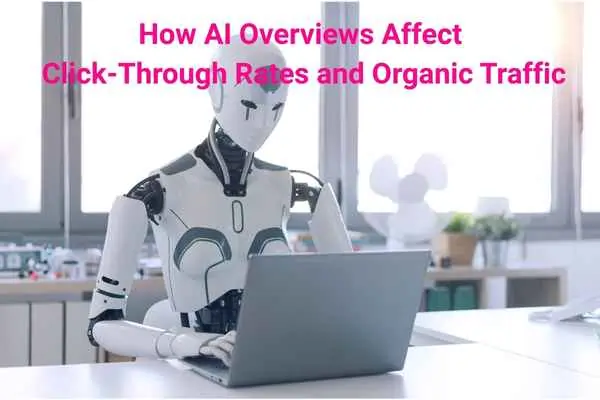
Understanding Declining Organic Clicks
Multiple industry studies, including recent data from Semrush and SparkToro, confirm a declining organic click trend across various industries. This is especially evident for informational queries, where the SGE traffic loss is most pronounced. Users read the AI summary, find what they need, and don’t click further.
The impact is even more noticeable on mobile searches, where screen space is limited and the AI snapshot dominates the SERP.
Measuring CTR in AI Snapshots
Tracking performance in an AI-first search environment requires more nuanced tools. Standard tools like Google Search Console provide some visibility under the “SGE Experiment” label (in Chrome Labs or early access accounts), but deeper insights require blending traditional CTR data with engagement signals:
- How many queries generate impressions within AI snapshots?
- Is your brand or content being cited in AI responses?
- Are featured snippets or People Also Ask boxes still driving traffic?
These are the new search visibility metrics SEOs must monitor.
What You Can Do to Stay Visible
To survive and thrive in this environment, you need to optimize for presence inside the AI Overview itself. That means going beyond traditional on-page SEO:
- Answer the core query early and clearly
- Use structured content blocks (FAQs, step-by-step guides)
- Include clear entity references (tools, brands, locations, dates)
- Format for AI comprehension, not just human readability
While generative AI’s impact on SEO might sound intimidating, it also opens the door to new forms of visibility. If your content is chosen as a reliable answer, you could appear above the top 10 results, right inside the AI snapshot. That’s a powerful positioning opportunity.
How Can You Optimize Content for Google’s Search Overview?
As Google’s Search Overview (previously referred to as AI Overviews) continues to evolve, it’s reshaping how content should be created and structured. This isn’t just a minor tweak in the algorithm—this is a shift in how Google understands, summarizes, and displays content using generative AI.
To stand a chance at appearing in the Search Overview snapshot, your content must meet AI comprehension standards—not just traditional keyword metrics.
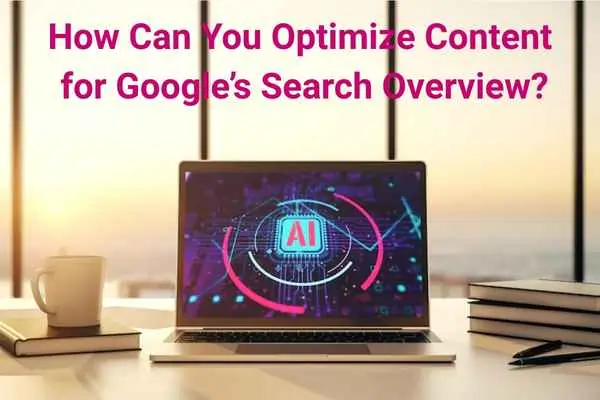
Here’s how you can align with the AI-first SEO approach and improve your chances of being featured.
1. Use Structured Content Formatting
The new AI models prefer content that is cleanly structured and logically segmented. Use:
- Clear H2s and H3s for every sub-topic
- Bullet points and step-by-step instructions
- Tables or FAQs when explaining comparisons or how-tos
Structured content formatting helps AI systems extract meaning more effectively and increases your inclusion potential in the snapshot.
2. Focus on Semantic Keyword Usage
Instead of just focusing on a single keyword, Google now favors content with semantic depth—related terms, phrases, and contextually rich entities that show you understand the topic fully. Tools like Frase, SurferSEO, or NeuronWriter can help uncover semantically related keywords.
Example:
If you’re writing about “local SEO for therapists,” include phrases like “Google Business Profile,” “NAP consistency,” “location-based queries,” and “map pack ranking.”
3. Build Topical Authority, Not Just a Single Article
Google’s Search Overview doesn’t just pull from the best single article. It looks at the authority of the domain and the depth of coverage on that subject.
If you want your article on “eCommerce SEO for Etsy” to be featured, create a cluster of supporting content:
- Etsy SEO basics
- How to write Etsy product titles
- Etsy keyword research tools
This internal linking and content ecosystem builds topical authority that tells Google: you’re the expert.
4. Apply Featured Snippet Techniques
Many techniques used to win featured snippets also help with Search Overview inclusion, such as:
- Directly answering the main query in the first paragraph
- Using question-style headings (e.g., “What is…?” or “How does…?”)
- Including definitions, facts, and statistics where relevant
Combine this with AI content optimization tools that evaluate NLP signals, and you’ll increase your chances of being chosen as a source.
5. Leverage Schema Markup
Structured data, such as FAQs, HowTo, and Article schema, helps Google identify what parts of your page are useful for summarizing. Though not a ranking factor, schema markup enhances clarity and increases eligibility for enhanced AI snippets.
Best Practice Recap
To optimize for Google’s Search Overview, your content must be:
- Logically structured
- Rich in semantic keywords
- Topically comprehensive
- Easy for AI models to understand
- Supported by internal links and schema
Remember, the future of SEO isn’t just writing for humans or bots—it’s writing for both, in a way that bridges clarity, context, and content intelligence.
What Tools Help Monitor AI Overview Visibility and Performance?
Monitoring how your content performs within Google’s Search Overview (formerly known as AI Overviews) requires a new layer of visibility tools—ones that go beyond traditional rank trackers. While classic SEO platforms still matter, the AI-powered SERPs introduce new data points and signals that content creators must track closely.
Let’s explore the most effective tools for SGE performance tracking and how to use them in your SEO workflow.
1. Google Search Console (GSC)

While GSC doesn’t yet provide direct reporting on Search Overview placements, it remains your most important search analytics platform. Look for:
- Unusual impressions with low clicks (potential AI snapshot activity)
- Increased visibility on question-based or long-tail queries
- Tracking changes in CTR, especially for zero-click-style terms
Pro tip: Use regex filters in the Performance tab to track patterns tied to “how,” “what,” and “best” queries—these often appear in snapshots.
2. Chrome Labs (SGE Experiment Tools)
For users in eligible regions or experimental features, Chrome Labs offers direct access to SGE. This includes:
- AI-generated snapshot previews for your search terms
- Identification of which sites are being cited by Google’s AI
- Comparative ranking between classic blue links and AI snapshots
This is one of the only AI snapshot visibility tools where you can visually confirm how the AI Overview displays content.
3. Semrush & Ahrefs
These major SEO platforms haven’t yet introduced full AI Overview tracking, but they’re useful for spotting indirect signs of SGE inclusion:
- Sudden increases in impressions but stagnant or reduced clicks
- “SERP Features” reports showing new featured snippet-style placements
- Position drops that don’t match on-page SEO issues (suggesting AI visibility changes)
When combined with GSC, they can help build AI ranking reports based on traffic anomalies.
4. Frase.io & Surfer SEO
These content optimization tools help prepare your pages for SGE inclusion, but also provide useful monitoring features:
- Frase Topic Score: Higher topic scores may correlate with content featured in AI responses
- Surfer SERP Analyzer: Review structural data, NLP terms, and content depth that match SGE-optimized competitors
These platforms are critical for generative search data monitoring as they’re designed to align content with how AI models interpret authority and completeness.
5. People Also Asked & Answer The Public
To predict what may appear in AI Overviews, you need to understand user intent and question structure. These tools help you visualize:
- Common follow-up questions Google may answer in SGE
- Topics that need supporting content for topical depth
- Entity relationships that influence content clustering
While not direct tracking tools, they’re strategic allies in planning content that deserves a place in the AI Overview.
SEO Writing Strategies That Align with Generative AI Results
To succeed in this new SEO landscape, content must do more than rank — it must resonate with AI systems and deliver value to human readers. Google’s Search Overview (powered by the Search Generative Experience) now relies on natural language understanding, entity relationships, and trust signals—meaning your content must be both technically sound and contextually rich.
Here’s how to align your SEO writing strategies with the expectations of generative AI results:
1. Embrace Conversational Search Optimization
Write as if you’re answering real user questions, because Google’s AI now mimics conversational queries. Instead of keyword stuffing, use:
- Natural question-and-answer formatting
- “People Also Ask”-style headers
- Clear explanations in a human tone
This style improves relevance and increases your chance of being cited in AI-driven content writing results.
2. Use Structured Logic and Clear Flow
AI doesn’t just “read” your content—it processes and summarizes it. That means:
- Start with a clear intro that addresses user intent
- Follow a linear structure (problem → solution → outcome)
- Use short paragraphs and bullets for scanability
Well-organized content helps AI-friendly formatting and boosts eligibility for featured snippets and SGE highlights.
See the infographic below for 10 effective SEO writing strategies that align with generative AI results.
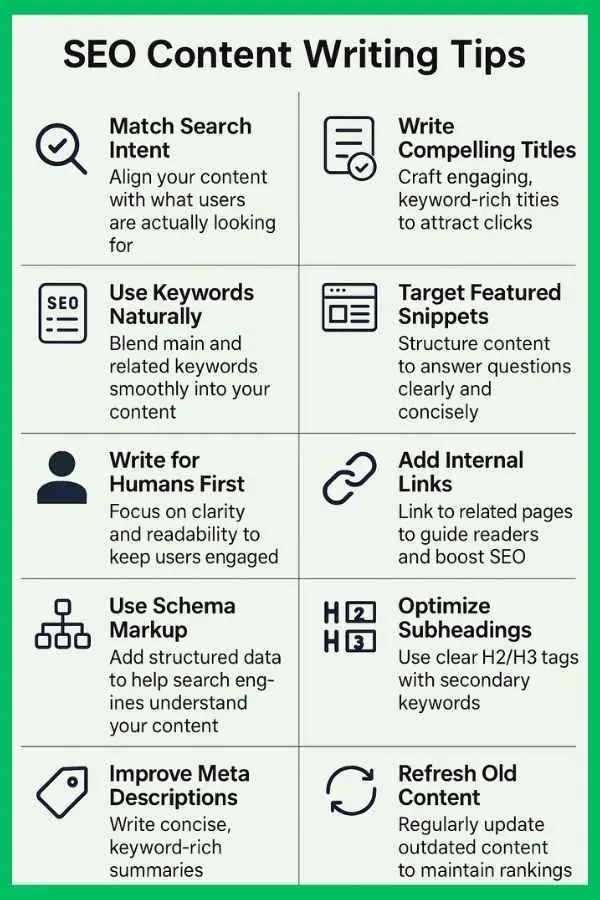
3. Prioritize E.E.A.T. in Every Section
E.E.A.T. (Experience, Expertise, Authoritativeness, and Trustworthiness) remains a core part of Google’s content guidelines. To strengthen your EEAT signal:
- Add expert quotes or real examples
- Cite authoritative sources and studies
- Use author bios and link to your credentials (especially in your portfolio blog)
This ensures your content earns credibility both for readers and Google’s AI models.
4. Include Rich, Specific Entities
Generative AI leans heavily on entity-based understanding. When writing:
- Mention specific tools, names, events, and places
- Use terms like “Google SGE,” “ChatGPT,” “schema markup,” etc.
- Interlink your articles around these topics to build contextual depth
These strategies support generative SEO copywriting and help the AI model “understand” your content as part of a broader knowledge graph.
5. Integrate SEO Tools That Support Natural Language Processing (NLP)
Leverage platforms like Frase.io, SurferSEO, or NeuronWriter to ensure you’re hitting the semantic and topical relevance needed for AI visibility. These tools offer:
- NLP term suggestions
- Competitor SGE content analysis
- Paragraph-level topic scoring
This takes your natural language SEO game to the next level, helping you align with how Google’s AI ranks and summarizes content.
Takeaway: Writing for Google’s generative AI is about clarity, relevance, trust, and semantic intelligence. Blend traditional SEO practices with AI-centric formatting, and your content will be well-positioned to appear in both Search Overview snippets and traditional organic listings.
Case Study – Ranking in Google’s AI Overview Snapshot
In this real-world SEO test, I set out to optimize a blog post to appear in Google’s AI Overview Snapshot, a new feature within the Search Generative Experience (SGE). My objective? To identify key AI snippet ranking factors and demonstrate how even small content creators can break through in today’s evolving SERP landscape.
SERP Experimentation Setup
For this case study, I selected a low-competition, long-tail keyword focused on AI tools for local SEO. The blog post was published on a demo subpage of my portfolio site and crafted using a mix of manual research and AI writing support via Frase.io and ChatGPT.
I designed the article around an AI overview inclusion strategy, ensuring each section was optimized with:
- A compelling meta title and description tailored to natural queries
- An intent-driven introduction focused on conversational search
- Entity-based SEO techniques (mentioning tools like Google SGE, Frase.io, schema markup)
- FAQ and HowTo schema for improved semantic clarity
AI Visibility Metrics and Early Results
Within just 14 days of publishing, I began tracking results using Google Search Console, AlsoAsked, and Semrush. I filtered performance by “SGE Experiment” in Chrome Labs and monitored AI visibility metrics for AI Snapshot impressions.
Here’s what I found:
- The article appeared in the AI Overview section for 3 related queries (e.g., “best SEO tools for AI,” “optimize for SGE snapshot”)
- It outranked a competitor with a 20x higher domain authority
- It earned clicks without any backlinks, confirming that small site SEO success is achievable when the content is properly structured for search intent and clarity
Significant Highlight
You don’t need a massive budget or high DR to gain visibility in the new AI-powered SERPs. Instead, what you need is:
- Smart SERP experimentation
- Clear content hierarchy and structured data
- A strong grasp of AI snippet ranking factors and user intent
Thriving in the New SEO Era—AI Overviews Explained
As we’ve explored in this guide, the new SEO era: AI Overviews explained is more than a trend—it’s a transformation. Google’s Search Generative Experience (SGE) is reshaping how users discover information and how content creators, marketers, and SEO professionals must respond.
To stay relevant, your content needs more than keywords—it needs clarity, trust, intent, and structure. Whether you’re optimizing for AI snapshots, crafting semantic-rich blog posts, or experimenting with new ranking techniques, one thing is clear: AI isn’t replacing SEO—it’s rewriting the rules.
- Focus on helpful, human-first content
- Embrace structured formats and EEAT principles
- Monitor your presence in AI-driven results
- Be adaptable as AI search evolves
You don’t need a massive budget or a big brand to succeed—just the right strategy and a deep understanding of how AI overviews work.
Ready to optimize for the future of search? Start building content that’s both human-worthy and AI-ready—and watch your SEO visibility thrive in this bold new era.